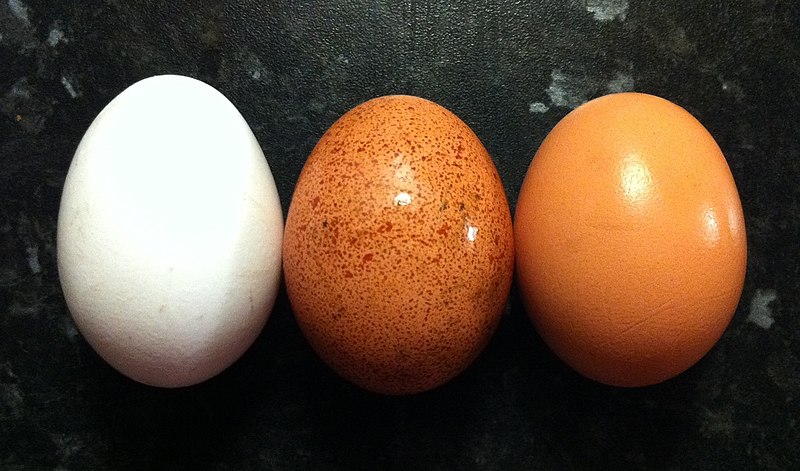Scaricare:

Informazioni generali
Uova
Latte
Yogurt
Formaggio
Pollame
Parole chiave
Prodotti tipici locali e varietà, latticini, proteine, consumo quotidiano, alimentazione sana
Livello
Informazioni generali
Gli alimenti che compongono il gruppo delle proteine di livello superiore, come il pollame, il latte, le uova, il formaggio e lo yogurt sono ricchi di un'ampia varietà di minerali. Il consumo di questi alimenti e la loro quantità devono essere in accordo con la fascia d'età e l'attività fisica dell'individuo.
Uova
Le uova che consumiamo di solito sono uova di gallina (Gallus gallus). L'Unione Europea regola la commercializzazione di queste uova con regole di produzione, commercializzazione, etichettatura e igiene.
Sistemi di produzione delle uova. A seconda del tipo di allevamento, le uova da consumo si chiamano:
Uova di galline in gabbia.
Uova di galline allevate all'aperto.
Uova di produzione biologica.
Prodotti a base di uova. Il termine “ovoprodotto” si riferisce a nuovi modi di presentare, conservare e commercializzare le uova fuori dal guscio, pronte per il consumo. Si tratta di un prodotto costituito principalmente da tutto o parte del contenuto delle uova.
Latte
Il latte è un alimento eccezionalmente ricco. Ci sono diversi modi di presentazione e trattamento per la sua conservazione.
I Latte liquidi:
- latte crudo;
- latte fresco pastorizzato;
- latte sterilizzato;
- UHT (sterilizzazione ad altissima temperatura).
Latte concentrato.
Latte evaporato.
Latte condensato.
Latte in polvere.
Yogurt
Lo yogurt è un latte fermentato ottenuto mescolando due batteri da latte: “streptococcus thermofilus” e “lactobacillus bulgaricus”. Alla fine della fermentazione (45°C per 2 ore), il latte coagulato si trasforma in yogurt.
- Yogurt naturale: senza additivi. A seconda della quantità di grasso, sono: interi, parzialmente scremati, scremati o arricchiti con panna.
- Yogurt semplice zuccherato: Con aggiunta di zucchero.
- Yogurt zuccherato: con aggiunta di dolcificanti autorizzati.
- Yogurt con frutta o succo.
- Yogurt aromatizzato: con aromi per dare diversi sapori.
Oltre a questi tipi di yogurt, possiamo trovare sul mercato altre varietà, come lo yogurt greco, in cui il siero liquido viene estratto dal latte, ottenendo un prodotto più denso, con meno zucchero e più proteine.
Il kefir è un latticino simile allo yogurt liquido, fermentato attraverso l'azione di un gruppo di lieviti e batteri chiamati anche grani o noduli.
Formaggio
Ci sono innumerevoli varietà di formaggio. Che sia fatto con latte di mucca, di pecora o di capra, esso è fatto usando il caglio, enzimi che coagulano e addensano il latte. Questo caglio può essere di origine animale (ottenuto dallo stomaco dei ruminanti in lattazione), vegetale (ottenuto dalla linfa di fico o di cardo), microbica o sintetica. L'acqua viene eliminata dal latte, quindi il formaggio è un concentrato di proteine, vitamine, sali minerali e grassi facilmente digeribili. Per tutti questi motivi, il formaggio è pieno di benefici per il nostro organismo, e l'OMS (Organizzazione Mondiale della Sanità) ne raccomanda il consumo.
Pollame
Il pollame è un uccello addomesticato utilizzato nell'alimentazione, per il consumo della sua carne. Il termine include tipicamente i membri degli ordini Galliforme, come polli e tacchini, e Anseriforme, uccelli acquatici come anatre e oche. Tuttavia, questa non è una classificazione rigida: il termine può anche riferirsi ad altri tipi di uccelli che vengono utilizzati in cucina, come i piccioni e persino gli struzzi. Per uccelli come il fagiano, la quaglia e le anatre selvatiche, si usa comunemente l’espressione "selvaggina da piuma".
Descrizione
Gli alimenti che compongono il gruppo delle proteine di livello superiore, come il pollame, il latte, le uova, il formaggio e lo yogurt sono ricchi di un'ampia varietà di minerali. Il consumo di questi alimenti e la loro quantità devono essere in accordo con la fascia d'età e l'attività fisica dell'individuo.
Etichette
Benefici
Dairy products are important for the proteins and vitamins they contain and for the calcium reserves needed by the body.
For people with lactose intolerance, we recommend lactose-free dairy products or products from other seeds such as soya beans enriched with calcium.
Eggs are one of the few foods that do not contain carbohydrates. Each egg is rich in fat, contains a considerable proportion of excellent protein, and good amounts of calcium, iron, vitamins A and D, as well as thiamine and riboflavin. Eggs have the nutri-tional disadvantage of a very high cholesterol con-tent found in the yolk.
Poultry, such as chicken and turkey, are good for heart health. Also, poultry costs less than meat and fish. How should I prepare poultry? Chicken can be baked, broiled, roasted, grilled or fried. If you fry chicken, use healthy vegetable oil. But not all ways of cooking poultry are suitable. Fried and battered chicken is high in fat and should not be eaten. In addition, spicy chicken, especially in fast food res-taurants, has a high salt content and is also not recommended.
Prodotti rappresentativi
The Payoya goat is an autochthonous Andalusian breed, capable of offering excellent milk production, the basis of an important cheese-making tradition.
Hens in Europe.In Europe there are more than 1000 types of chicken breeds, here are some examples.
The Padua hen, Padovana or "tufted hen" is a hen of British origin.
Leghorn hens of Mediterranean origin, specifically Italian.
Gallic Bresse. Originating from Bresse, France. The Faverolles hen is another French breed of hen.
Alsatian hen. They originate from Alsace, a region formerly French, but now divided between France and Germany.
The Portuguese Pedresa hen (in Portuguese, galinha pedrês portuguesa) is a native breed originating in northern Portugal.
Hens in Malaga and Andalusia, the vast majority of which are of Mediterranean type, the following breeds stand out as autochthonous breeds: Armiñada, Azul, Blanca, Caniza, Franciscana, Negra and Perdiz.
Rischi alimentari
An open egg is an ideal medium for microbial growth; it is therefore preferable to open eggs just at the time of use. In addition, the natural bacteri-cide contained in the egg white (lysozyme) becomes ineffective in contact with air and no longer pro-tects the egg.
Ulteriori informazioni
Further references Webgraphyin English:
https://www.uspoultry.org/
https://www.cheese.com/
https://www.yogurtinnutrition.com/
https://www.bbcgoodfood.com/howto/guide/ingredient-focus-eggs
https://ec.europa.eu/info/food-farming-fisheries/animals-and-animal-products/animal-products/milk-and-dairy-products_en
Webgraphy in Spanish:
https://ochosabores.com/hecho-en-andalucia/quesos-andaluces-que-son-un-tesoro/
https://www.institutohuevo.com/
http://www.saboramalaga.es/
https://www.payoya.com/raza
https://www.granjasantaisabel.com/gallinas-razas-autoctonas.php
 Riprodurre l’audio
Riprodurre l’audio

